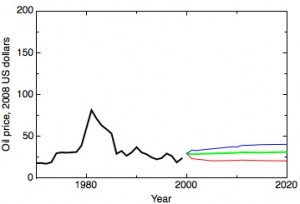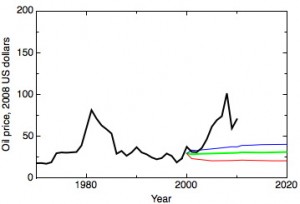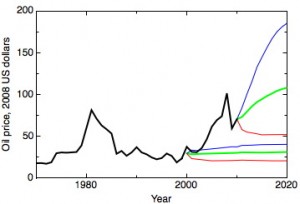I’ve taken part in panel discussions at two events with a strong Science and Technology Studies flavour in the last couple of months. “Democratising Futures” was a meeting under the auspices of the Centre for Research in Arts, Social Sciences and Humanities, at Cambridge on 27 May 2010. The Science and Democracy Network’s meeting was held in association with the Royal Society at the Kavli Centre on the 29 June 2010. What follows is a composite of the sorts of things I said at the two meetings.
“There is no alternative” is a phrase with a particular resonance in British politics, but it also expresses a way of thinking about the progress of science and technology. To many people, science and technology represent an autonomous force, driven forward by its own internal logic. In this view, the progress of science and technology cannot effectively steered, much less restrained. I think this view is both wrong and pernicious.
The reality is that there are very many places in which decisions and choices are made about the directions of science and technology. These include the implicit decisions made by the (international) scientific community, as a result of which the fashionable and timely topics of the day acquire momentum, much more explicit choices made by funding agencies in what areas they attach funding priority to, as well as preferences expressed by a variety of actors in the private sector, whether those are the beliefs that inform investment decisions by venture capitalists or the strategic decisions made by multinational companies. It’s obvious that these decisions are not always informed by perfect information and rationality – they will blend informed but necessarily fallible judgements about how the future might unfold with sectional interests, and will be underpinned by ideology.
To take an example which I don’t think is untypical, in the funding body I know best, the UK’s Engineering and Physical Sciences Research Council (EPSRC), priorities are set by a mixture of top-down and bottom-up pressures. The bottom-up aspect comes from the proposals the council receives, from individual scientists, to pursue those lines of research that they think are interesting. From the top, though, comes increasing pressure from government to prioritise research in line with their broad strategies.
In setting a strategic framework, EPSRC distinguishes between the technical opportunities that the current state of science offers, and the demands of “users” of research in industry and research. Advice on the former typically comes from practising scientists, who alone have the expertise to know what is possible. This advice won’t be completely objective, of course – it will be subject to the whims of academic fashion and a certain incumbency bias in favour of established, well-developed fields. The industrial scientists who provide advice will of course have a direct interest in science that benefits their own industries and their own companies. Policy demands supporting science that can be translated into the marketplace, but this needs to be balanced against a reluctance to subsidise the private sector directly. Even accepting the desirability of supporting science that can be taken to market quickly, there is also an incumbency bias here too. Given that this advice necessarily comes from people representing established concerns, who is going to promote the truly disruptive industries?
So, given these routes by which scientists and industry representatives have explicit mechanisms for influencing the agenda and priorities for publicly funded science, the big outstanding question is how the rest of the population can have some influence. Of course, research councils are aware of the broader societal contexts that surround the research they fund; and the scientists and industry people providing advice will be asked to incorporate these broader issues in their thinking. The danger is that these people are not well equipped to make some judgements. In a phrase of Arie Rip, it’s likely that they will be using “folk social science” – a set of preconceptions and prejudices, unsupported by evidence, about what the wider population thinks about science and technology (one very common example of this in the UK is the proposition that one can gauge probable public reactions to science by reading the Daily Mail).
It might be argued that the proper way for wider societal and ethical issues to be incorporated in scientific priority setting is through the usual apparatus of representative democracy – in the UK system, through Ministers who are responsible to Parliament. This fails in practise for both institutional and practical reasons. There is a formal principle in the UK known as the Haldane principle (like much else in the UK this is probably an invented tradition), which states that science should be governed at one remove from government, with decisions being left to scientists. The funding bodies – the research councils – are not direct subsidiaries of their parent government department, but are free-standing agencies. This doesn’t stop them from being given a strong strategic steer, both through informal and formal routes, but they generally resist taking direct orders from the Minister. But there are more general reasons why science resists democratic oversight through traditional mechanisms – it is at once too big and too little an issue. The long timescales of science and the convoluted routes by which it impacts on everyday life; the poor understanding of science on the part of elected politicians; the lack of immediate feedback from the electorate in the politicians’ postbags – all these factors contribute to science not having a high political profile, despite the deep and fundamental impacts it has on the way people live.
Here, then, is the potential role of public engagement – it should form a key input into identifying what potential goals of science and technology might have broad societal support. It was in recognition of these sorts of issues that EPSRC introduced a Societal Issues Panel into its advisory structure – this a high-level strategic advice panel on a par with the Technical Opportunities Panel and the User Panel.
Another development in the way people are thinking about scientific priority setting makes these issues even more pointed – this is the growing popularity across the world of the idea of the “Grand Challenge” as a way of organising science. Here, we have an explicit link being made between scientific priorities and societal goals – which leads directly to the question “whose goals?”
Grand Challenges provide a way of contextualising research that goes beyond a rather sterile dichotomy between “applied” and “blue sky” research – it supports work that has some goal in mind, but a goal that is more distant than the typical object of applied research, and is often on a larger scale. The “challenge” or context is typically based on some larger societal goal, rather than on a question arising from a scientific discipline. This might be a global problem, such as the need to develop a low carbon energy infrastructure or ensure food security for a growing population, or something that is more local to a particular country or group of countries, such as the problems of ageing populations in the UK and other developed countries. The definition in terms of a societal goal necessarily implies that the work needs to be cross-disciplinary in character, and there is growing recognition in principle of the importance of social sciences.
An example of the way in which public engagement could help steer such a grand challenge programme was given by the EPSRC’s recent Grand Challenge in Nanotechnology for Medicine and Healthcare. Here, a public engagement exercise was designed with the explicit intention of using what emerged as an input, together with expert advice from academic scientists, clinicians and industry representatives, into a decision about how to shape the priorities of the programme.
I’ve written in more detail about this process elsewhere. Here, it’s worth stressing what made this programme particularly suitable for this approach. The proposed research was framed explicitly as a search for technological responses to societal issues, so it was easy to argue that public attitudes and priorities were an important factor to consider. The area is also strongly interdisciplinary; this makes the traditional approaches of relying solely on expert advice less effective. Very few, if any, individual scientists have expertise that crosses the range of disciplines that is necessary to operate in the field of nanomedicine, so technical advice needs to integrate the contributions of people expert in areas as different as colloid chemistry and neuroscience, for example.
The outcome of the public engagement provided rich insights that in some cases surprised the expert advisors. These insights included both specific commentaries on the proposed areas of research that were being considered (such as the use of nanotechnology enabled surfaces to control pathogens) and a more general filter – the idea that a key issue in deciding people’s response to a proposed technology was the degree to which it gave or took away control and empowerment from the individual. Of course, people were concerned about issues of risk and regulation, but the form of the engagement was such that much broader questions than the simple question “is it safe” were discussed.
I believe that this public engagement was very successful, because it concerned a rather concrete and tightly defined technology area, it was explicitly linked to a pending funding decision, and there was complete clarity about how it would contribute, together with more conventional consultations, to that decision – that is, what kind of applications of nanotechnology to medicine and healthcare a forthcoming funding call would prioritise. Of course, there are still many open questions about using public engagement more widely in this sort of priority setting.
The first issue is the question of scope – at what level does one ask the question? For example, in the area of energy research, one could ask, should we have a programme of energy research, and if so how big? Or, taking the answer to that question as given, one could ask whether research in biofuels should form a part of the energy programme? Or one could ask what kind of biofuel should we prioritise. My experience from a variety of public engagement exercises in the area of nanotechnology is that the more specific the question, the easier it is for people to engage with the process. But the criticism of focusing public engagement down in this way is that one can be accused, by focusing on the details, of taking the answers to the big questions as read.
But the big questions are fundamentally questions of politics in its proper sense. They are questions about what sort of world we want to live in and what kinds of lives we want to lead. The inescapable conclusion, for me, is that the explicit linkage of science and this kind of politics – the politics of big questions about society’s future – is both inevitable and desirable.
Many scientists will instinctively recoil from this this enmeshing of science and politics. I think this is a mistake. It is less controversial to say we need more science in politics – since so many of the big issues we face have a scientific dimension, most people agree that decisions on these issues need to be informed by science. But we also need to recognise that we need more explicit recognition of the political dimensions of science – because the science we do has such potential to shape the way our society will change, we need positive visions of those changes to steer the way science develops. So, we need more science in politics, and more politics in science. And, when it comes to it, we probably need more politics in politics too.
In addition to these more fundamental questions, there are some very practical linked issues related to the scale of the engagement exercises one does, their methodological robustness, and their cost. Social scientists can contribute a great deal to understanding how to make them as reliable as possible, but I believe that a certain pragmatism is called for when one considers their inevitable methodological shortcomings – they need to be seen as one input into a decision making process that already falls short of perfection. This is inevitable; it is expensive in money and time to do these exercises properly. The UK research councils seem to have settled down to an informal understanding that they will do one or two of these exercises a year on topics that seem to the be most potentially controversial. Following the nanomedicine dialogue, there have been recently completed exercises on synthetic biology and geo-engineering. But we will see how strong the will is to continue in this way in an environment with much less money around.
In addition to practical difficulties, there are people who oppose in principle any use of public engagement in setting scientific priorities. One can identify perhaps three classes of objections. The first will come from those scientists who oppose any infringement of the sovereignty of the “independent republic of science”. The second can be heard from some politicians, who regard the use of direct public engagement as an infringement of the principles of representative democracy. The third will come from free market purists, who will insist that the market provides the route by which informal, non-scientific knowledge is incorporated in decisions about how technology is developed. I don’t think any of these objections is tenable, but that’s the subject for a much longer discussion.


